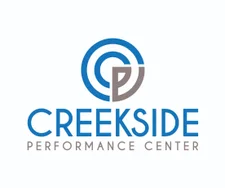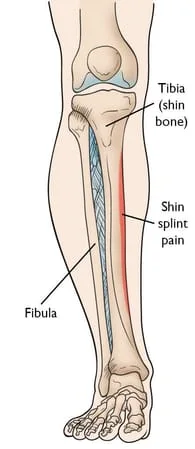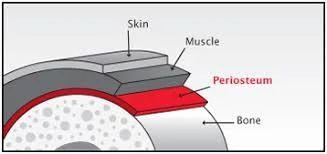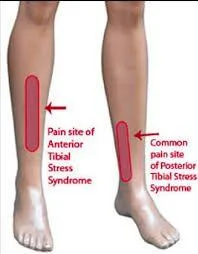Shin Splints
What is the medical term for shin splints?
Medial tibial stress syndrome (MTSS), aka Medial Tibial Traction Periostitis, describes exercise-induced pain along the inside of the tibia. The condition is commonly referred to as “Shin splints” and is a familiar malady and affects about 33 % of athletes (1-4).
Are shin splints common in runners?
Yes, shin splints are responsible for approximately 15% of all running injuries (1).
What causes shin splints?
Shin splints are believed to result from repetitive contraction of the deep ankle flexors during running, jumping, or impact loading (5). Repetitive traction on the medial tibial crest results in myofascial strain, inflammation, and bony stress reaction (6-13).
What actually causes the pain in shin splints?
Early theories focused on myofascial strain, but current evidence suggests that a bony stress reaction (called periostitis) is the most likely cause of MTSS (14-20).
Shin splints and stress fractures
Newer research suggests that traction periostitis may be an inflammatory precursor to tibial stress fracture (21) The stress of exercise can weaken bone. Healthy bone responds to this stress by remodeling itself more densely. Stress reactions occur when the normal adaptive remodeling response is unable to keep pace with the loads of excessive training: high demands with inadequate recovery times (22,23). Prolonged insult may lead to tibial stress fracture (24,25).
Shin splints and athletes
The leading mechanism of injury is repetitive eccentric contraction from running or jumping on hard surfaces (the landing portion of each step is eccentric) (26-28). Excessive or improper training is the leading factor for the development of shin splints (2,3,29-33). Common training errors include the terrible too’s (too much, too fast, too long) (31-34). Athletes who run more than 20 miles per week are at increased risk of developing shin splints (35). Inexperienced runners or those with poor technique are at greater risk (4). Running with a narrow or “crossover” gait increases tibial stress (87).
What are the risk factors for shin splints?
Foot hyperpronation is a significant risk factor for the development of shin splints, as a collapsing foot puts additional stress on the suspect tissues (4,10,12,14,28,36).
Interestingly, the use of orthotics is associated with the development of MTSS, although orthotic use should not be viewed as an independent risk factor since those using orthotics are likely to hyperpronate (4).
Females are affected more frequently and have a 150-350% increased likelihood of progressing to stress fracture (4,37).
Other risk factors include a prior history of shin splints and increased BMI (4).
Hip abductor weakness is a common culprit of many lower chain overuse injuries (86). Excessive external rotation of the hip is another known contributor (4,50).
What are the symptoms of shin splints?
The pesentation of shin splints includes vague, diffuse pain over the middle to distal inside of the tibia. Athletes often present following an increase in activity intensity or duration. Symptoms are often worse with exertion – particularly at the beginning of a work-out (38).
Initially, symptoms may subside during training, but as the condition progresses, symptoms may linger throughout activity or even at rest (38). Pain that persists more than five minutes post-activity carries a higher suspicion of stress fracture (49).
Prolonged stress may generate a periosteal reaction detectable as a “rough” or “bumpy” feel (39).
Do I need X-rays or imaging for shin splints?
Imaging of early and uncomplicated MTSS is often unnecessary (53). Imaging is appropriate in the presence of: red flags, focal tenderness, pain at rest, or when the patient fails to improve with a reasonable trial of conservative care (53). Radiographs taken within the first 2-3weeks are not likely to show any change; however, patients with longstanding MTSS may demonstrate periosteal reaction indicating callus formation and stress fracture (55).
Plain films frequently do not demonstrate the signs of tibial stress fracture (42,56,57). Unresponsive patients or those with a higher likelihood of stress fracture (runners) may benefit from advanced imaging, including MRI or bone scan (58). MRI is highly sensitive (74-100%) and is best able to grade the progression of stress reaction (59-61).
What is the best management of shin splints?
No intervention has proven more successful than rest for the management of shin splints.
The successful management of shin splints requires the removal of risk factors, and rest.
Athletes may need to decrease frequency, intensity, and duration of impact activities, including running and jumping. Athletes may need to consider non-weight bearing cross-training like stationary cycling or pool running.
Initially, anti-inflammatory modalities, including ultrasound or e-stim may provide relief. (67) Ice or home ice massage may provide an anti-inflammatory or palliative benefit.
Resolution of shin splints requires correction of any associated kinetic chain dysfunction (68-70). Stretching exercises and myofascial release are appropriate for muscles around the leg and hip. (71) Strengthening exercises may be appropriate for weak hip and ankle musculature. Manipulation may be employed to resolve joint restrictions in the spine, sacroiliac joint, pelvis, and lower extremity (69,70,74).
Arch supports or custom orthotics may be appropriate for patients with fallen arches (75), although at least one contradictory systematic review suggests that orthotics may be causative and are not useful for prevention (76).
Additional possibilities for the management of shin splints include dry needling and acupuncture (74,80).
When can I return to activity with shin splints?
Return to activity should start slowly with a graded running program, beginning with a 1/4 mile run and progressing by 1/4 mile each time the athlete has no pain for two consecutive workouts (82).
Athletes should initially avoid running on hard or uneven surfaces and begin at a lower intensity and distance, increasing by no more than 10-15% per week.
Runners should first increase distance, then pace, and avoid hard or unlevel surfaces, including hills. Runners with a narrow gait may benefit from incorporating a wider step width (87).
Running shoes lose half of their shock absorption capacity after 300-500 miles and should be replaced within that range (83-85).
What other treatment options are available?
Surgical intervention is rarely utilized in this condition (74).
At Creekside Chiropractic & Performance Center, we are highly trained to treat shin splints. We are the only inter-disciplinary clinic providing services to Sheboygan, Sheboygan Falls, Plymouth, and Oostburg including chiropractic, manual therapy, myofascial release, ART (Active Release Technique), massage therapy, acupuncture, physiotherapy, rehabilitative exercise, nutritional counseling, personal training, and golf performance training under one roof. Utilizing these different services, we can help patients and clients reach the best outcomes and the best versions of themselves. Voted Best Chiropractor in Sheboygan by the Sheboygan Press.
Evidence Based-Patient Centered-Outcome Focused
Sources:
1. Clement DB, Taunton JE, Smart GW, McNicol KL. A survey of overuse running injuries. Phys Sportsmed 1981;9:47-58. Cited in Yates B, Allen MJ, Barnes MR. Outcome of surgical treatment of medial tibial stress syndrome. J Bone Joint Surg Am 2003;85(10):1974-1980.
2. Almeida S, Trone D, Leone D, Shaffer R. Gender differences in musculoskeletal injury rates: a function of symptom reporting? Med Sci Sports Exerc 1999;31:1807-1812. cited in Yates B, White S. The Incidence and Risk Factors in the Development of Medial Tibial Stress Syndrome Among Naval Recruits. Am J Sports Med 2004;32(3):772-780
3. Yates B, White S. The incidence and risk factors in the development of medial tibial stress syndrome among naval recruits. Am J Sports Med 2004;32(3):772-780.
4. Phil Newman, Jeremy Witchalls, Gordon Waddington, and Roger Adams Risk factors associated with medial tibial stress syndrome in runners: a systematic review and meta-analysis J Sports Med. 2013; 4: 229–241.
5. Bouché RT, Johnson CH. Medial tibial stress syndrome a proposed pathomechanical model involving fascial traction. JAPMA 2007;97(1):31-36.
6. Mubarak SJ, Gould RN, Lee YF, Schmidt DA, Hargens AR. The medial tibial stress syndrome a cause of shin splints. Am J Sports Med. 1982;10(4):201–205.
7. Michael RH, Holder LE. The soleus syndrome. A cause of medial tibial stress (shin splints) Am J Sports Med. 1985;13(2):87–94.
8. Bhatt R, Lauder I, Finlay DB, Allen MJ, Belton IP. Correlation of bone scintigraphy and histological findings in medial tibial syndrome. Br J Sports Med. 2000;34(1):49–53.
9. Johnell O, Rausing A, Wendeberg B, Westlin N. Morphological changes in shin splints. Clin Orthop Relat Res. 1982;(167):180–184
10. Messier SP, Pittala KA. Etiologic factors associated with selected running injuries. Med Sci Sports Exerc 1988; 20(5):501-5.
11. Craig DI. Medial tibial stress syndrome: evidence-based prevention. J Athl Train 2008; 43(3):316-18.
12. Viitsalo JT, Kvist M. Some biomechanical aspects of the foot and ankle in athletes with and without shin splints. Am J Sports Med 1983; 11(3):125-130.
13. Krivickas LS. Anatomical factors associated with overuse sports injuries. Sports Med 1997; 24(2):132-46.
14. Beck BR. Tibial stress injuries: an aetiological review for the purposes of guiding management. Sports Med. 1998;26(4):265–279
15. Magnusson HI, Ahlborg HG, Karlsson C, Nyquist F, Karlsson MK. Low regional tibial bone density in athletes with medial tibial stress syndrome normalizes after recovery from symptoms. Am J Sports Med. 2003;31(4):596–600
16. Magnusson HI, Westlin NE, Nyqvist F, Gärdsell P, Seeman E, Karlsson MK. Abnormally decreased regional bone density in athletes with medial tibial stress syndrome. Am J Sports Med. 2001;29(6):712–715.
17. Batt ME, Ugalde V, Anderson MW, Shelton DK. A prospective controlled study of diagnostic imaging for acute shin splints. Med Sci Sports Exerc. 1998;30(11):1564–1571.
18. Fredericson M, Bergman AG, Hoffman KL, Dillingham MS. Tibial stress reaction in runners correlation of clinical symptoms and scintigraphy with a new magnetic resonance imaging grading system. Am J Sports Med. 1995;23(4):472–481.
19. Gaeta M, Minutoli F, Scribano E, et al. CT and MR imaging findings in athletes with early tibial stress injuries: comparison with bone scintigraphy findings and emphasis on cortical abnormalities. Radiology. 2005;235(2):553–561.
20. Moen MH, Tol JL, Weir A, Steunebrink M, De Winter TC. Medial tibial stress syndrome: a critical review. Sports Med. 2009;39(7):523–546.
21. Tweed JL, Avil SJ, Campbell JA, Barnes MA. Etiologic factors in the development of medial tibial stress syndrome: a review of the literature. JAPMA 2008;98(2):107-111.
22. Anderson MW, Greenspan A. Stress fractures. Radiology 1996; 199(1):1-12.
23. Roub W, Gumerman LW, Hanley EN, et al. Bone stress: a radionuclide imaging perspective. Radiology 1979; 132(2):431-8.
24. Arendt EA, Griffiths HJ. The use of MR imaging in the assessment and clinical management of stress reactions of bone in high-performance athletes. Clin Sports Med 1997; 16(2):291-306.
25. Johnson LC, Stradford HT, Geis RW, Dineen JR, Kerley E. Histogenesis of stress fractures. JBJS 1963; 45A:1542.
26. Slocum DB. The shin splint syndrome. Medical aspects and differential diagnosis. Am J Surg 1967; 114(6):875-881.
27. James S, Ali K, Pocock C, Robertson C, Walter J, Bell J. Ultrasound guided dry needling and autologous blood injection for patellar tendinosis. Br J Sports Med. 2007;41(8):518–522
28. Bouché RT, Johnson CH. Medial tibial stress syndrome a proposed pathomechanical model involving fascial traction. JAPMA 2007;97(1):31-36.
29. Street D. Medial Tibial Stress Syndrome in Sporting Adults: A Clinical Management Guideline. Podiatry & Posture Ltd
30. Galbraith R et al. Medial tibial stress syndrome: conservative treatment options. Curr Rev Musculoskelet Med. Sep 2009; 2(3): 127–133.
31. Kortebein P, Kaufman K, Basford J, Stuart M. Medial tibial stress syndrome. Med Sci Sports Exerc. 2000;32(3 suppl):S27–S33
32. Fredericson M. Common injuries in runners. Diagnosis, rehabilitation and prevention. Sports Med. 1996;21:49–72.
33. Wilder R, Seth S. Overuse injuries: tendinopathies, stress fractures, compartment syndrome, and shin splints. Clin Sports Med. 2004;23:55–81.
34. Strakowski J, Jamil T. Management of common running injuries. Phys Med Rehabil Clin N Am. 2006;17(3):537–552.
35. Dugan S, Weber K. Stress fracture and rehabilitation. Phys Med Rehabil Clin N Am. 2007;18(3):401–416.
36. Bartosik KE, Sitler M, Hillstrom HJ, Palamarchuk H, Huxel K, Kim E. Anatomical and biomechanical assessments of medial tibial stress syndrome. J Am Podiatr Med Assoc. 2010;100(2):121–132.
37. Dugan S, Weber K. Stress fracture and rehabilitation. Phys Med Rehabil Clin N Am. 2007;18(3):401–416.
38. Kortebein P, Kaufman K, Basford J, Stuart M. Medial tibial stress syndrome. Med Sci Sports Exerc. 2000;32(3 suppl):S27–S33
39. Yates B, White S. The incidence and risk factors in the development of medial tibial stress syndrome among naval recruits. Am J Sports Med 2004;32(3):772-780.
40. Lesho EP. Can tuning forks replace bone scans for identification of tibial stress fractures? Mil Med. 1997;162(12):802–803.
41. Clement DB, Ammann W, Taunton JE, et al. Exercise-induced stress injuries to the femur. Int J Sports Med. 1993;14(6):347–352.
42. Ishibashi Y, Okamura Y, Otsuka H, Nishizawa K, Sasaki T, Toh S. Comparison of scintigraphy and magnetic resonance imaging for stress injuries of bone. Clin J Sport Med. 2002;12(2):79–84.
43. Batt ME, Ugalde V, Anderson MW, Shelton DK. A prospective controlled study of diagnostic imaging for acute shin splints. Med Sci Sports Exerc. 1998;30(11):1564–1571.
44. Yates B, White S. The incidence and risk factors in the development of medial tibial stress syndrome among naval recruits. Am J Sports Med 2004;32(3):772-780
45. Newman P, Adams R, Waddington G. Two simple clinical tests for predicting onset of medial tibial stress syndrome: shin palpation test and shin oedema test. Br J Sports Med. 2012;46(12):861–864.
46. Beck B. Tibial stress injuries: an aetiological review for the purposes of guiding management. Sports Med. 1998;26(4):265–279.
47. M Winters, H Veldt, E W Bakker, M H Moen. Intrinsic factors associated with medial tibial stress syndrome in athletes: A large case-control study S Afr J SM 2013;25(3):63-67.
48. Bennett JE, Reinking MF, Pluemer B, et al. Factors contributing to the development of medial tibial stress syndrome in high school runners. J Orthop Sports Phys Ther 2001:31(9):504-510.
49. Kirby KA. Foot and lower extremity biomechanics II: Precision Intricast newsletters, 2002-2008. Precision Intricast Inc., Payson, Ariz., 2009.
50. Burne SG, Khan KM, Boudville PB, et al. Risk factors associated with exertional tibial pain: A twelve months prospective clinical study. Br J Sports Med 2004:38(4):441-445.
51. Strakowski J, Jamil T. Management of common running injuries. Phys Med Rehabil Clin N Am. 2006;17(3):537–552.
52. Dugan S, Weber K. Stress fracture and rehabilitation. Phys Med Rehabil Clin N Am. 2007;18(3):401–416.
53. Mellion M, Walsh W, Madden C, Putukian M, Shelton G. The team physician’s handbook. 3rd ed. Philadelphia, PA: Hanley & Belfus; 2002. p. 517, 583.
55. Couture C, Karlson K. Tibial stress injuries: decisive diagnosis and treatment of ‘shin splints’. Phys Sportsmed. 2002;30(6):29–36
56. Berger F, de Jonge M, Smithuis R, Maas M. Stress Fractures. www.radiologyassistant. 5/23/07. accessed 6/21/14.
57. Matheson GO, Clement DB, McKenzie DC, Taunton JE, Lloyd-Smith DR, MacIntyre JG. Stress fractures in athletes. A study of 320 cases. Am J Sports Med. 1987;15(1):46–58.
58. Young A, McAllister D. Evaluation and treatment of tibial stress fractures. Clin Sports Med. 2006;25(1):117–128.
59. Fredericson M, Bergman G, Hoffman K, Dillingham M. Tibial stress reaction in runners: correlation of clinical symptoms and scintigraphy with a new magnetic resonance imaging grading system. Am J Sports Med. 1995;23:427–481
60. Gaeta M, Minutoli F, Scribano E, et al. CT and MR imaging findings in athletes with early tibial stress injuries: comparison with bone scintigraphy findings and emphasis on cortical abnormalities. Radiology. 2005;235(2):553–561.
61. Fredericson M, Bergman AG, Hoffman KL, Dillingham MS. Tibial stress reaction in runners. Correlation of clinical symptoms and scintigraphy with a new magnetic resonance imaging grading system. Am J Sports Med. 1995;23(4):472–481.
62. Fredericson M, Wun C. Differential diagnosis of leg pain in the athlete. JAPMA 2003; 93(4):321-4.
63. Schon LC, Baxter DE, Clanton TO. Chronic exercise-induced leg pain in active people: more than just shin splints. Phys Sports Med 1992; 20:100-114.
64. Korkola M, Amendola A. Exercise-induced leg pain. Sifting through a broad differential. Phys Sportsmed. 2001;29(6):35–50
65. Fredericson M. Common injuries in runners. Diagnosis, rehabilitation and prevention. Sports Med. 1996;21:49–72.
67. Galbraith RM, Laverlee ME. Medial tibial stress syndrome: conservative treatment options. Cur Rev Musculoskelet Med 2009;2:127-133.
68. Wilder R, Seth S. Overuse injuries: tendinopathies, stress fractures, compartment syndrome, and shin splints. Clin Sports Med. 2004;23:55–81.
69. Greenman P. Principles of manual medicine. 3rd ed., chap. 11. Philadelphia, PA: Lippincott Williams & Wilkins; 2003: p. 337–403, 489.
70. Karageanes S. Principles of manual sports medicine. Philadelphia, PA: Lippincott, Williams and Wilkins; 2005. pp. 467–468.
71. Strakowski J, Jamil T. Management of common running injuries. Phys Med Rehabil Clin N Am. 2006;17(3):537–552.
74. Galbraith RM, Laverlee ME. Medial tibial stress syndrome: conservative treatment options. Cur Rev Musculoskelet Med 2009;2:127-133.
75. Rome K, Handoll HH, Ashford R. Interventions for preventing and treating stress fractures and stress reactions of bone of the lower limbs in young adults. Cochrane Database Syst Rev. 2005;(2):CD000450.
76. Richter RR, Austin TM, Reinking MF. Foot orthoses in lower limb overuse conditions: a systematic review and meta-analysis-critical appraisal and commentary. J Athl Train. 2011;46(1):103–106.
77. Zimmermann WO, Paantjes MA: Sport compression stockings: user satisfaction 50 military personnel. Dutch J Mil Med 2009, 62:209-213.
78. Roelofsen J, Klein-Nulend J, Burger EH: Mechanical stimulation by intermittent hydrostatic compression promotes bone-specific gene expression in vitro. J Biomech 1995, 33(12):1493-1503.
79. Moen MH, Bongers T, Bakker EWP, Weir A, Zimmerman WO, van der Werve M, Backx FJG. The additional value of a pneumatic leg brace in the treatment of recruits with medial tibial stress syndrome; a randomised study. JR Army Med Corps 2010;156(4):236-240.
80. Ravin T, Cantieri M, Pasquarello G. Principles of prolotherapy, vol. 233. Denver, CO: American Academy of Musculoskeletal Medicine; 2008. p. 250–1
81. Moen MH, Rayer S, Schipper M, Schmikli S, Weir A, Tol JL, Backx FJG. Shockwave treatment for medial tibial stress syndrome in athletes; a prospective controlled study. Br J Sports Med 2011;10.1136/bjsm.2010.081992.
82. Moen et al. The treatment of medial tibial stress syndrome in athletes; a randomized clinical trial. Sports Medicine, Arthroscopy, Rehabilitation, Therapy & Technology 2012, 4:12
83. Messier SP, Edwards DG, Martin DF, et al. Etiology of Iliotibial Band Friction Syndrome in Distance Runners. Medicine & Science in Sports & Exercise 1995; 27(7):951-60.
84. Reid DC. Sports Injury Assessment and Rehabilitation. New York:Churchill Livingston, 1992.
85. Messier SP, Edwards DG, Martin DF, et al. Etiology of Iliotibial Band Friction Syndrome in Distance Runners. Medicine & Science in Sports & Exercise 1995; 27(7):951-60.
86. Niemuth P, Johnson R, Myers M, Thieman T. Hip muscle weakness and overuse injuries in recreational runners. Clin J Sport Med. 2005;15(1):14–21.
87. Meardon SA, Derrick TR. J Biomech. Effect of step width manipulation on tibial stress during running. 2014 Aug 22;47(11):2738-44.




